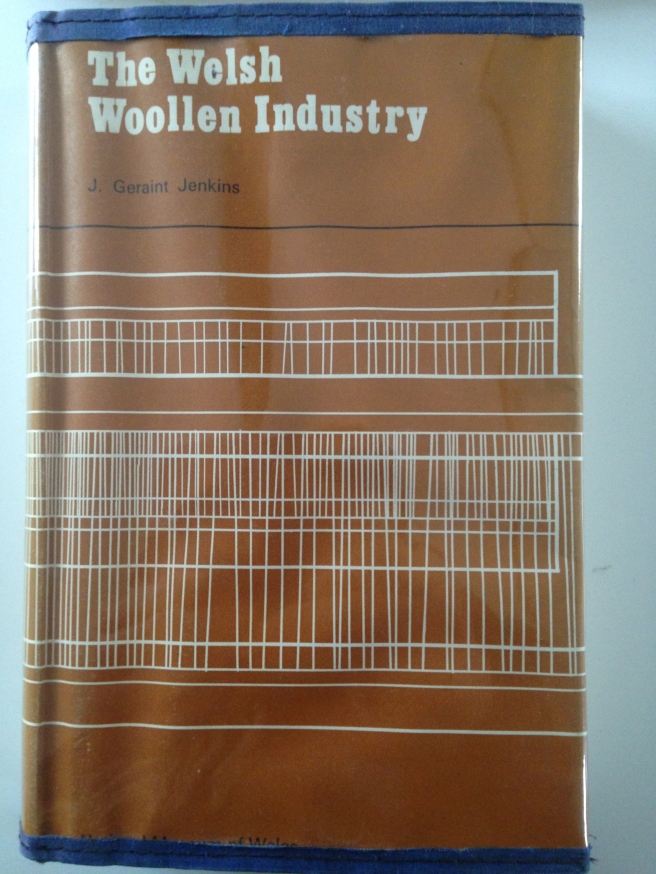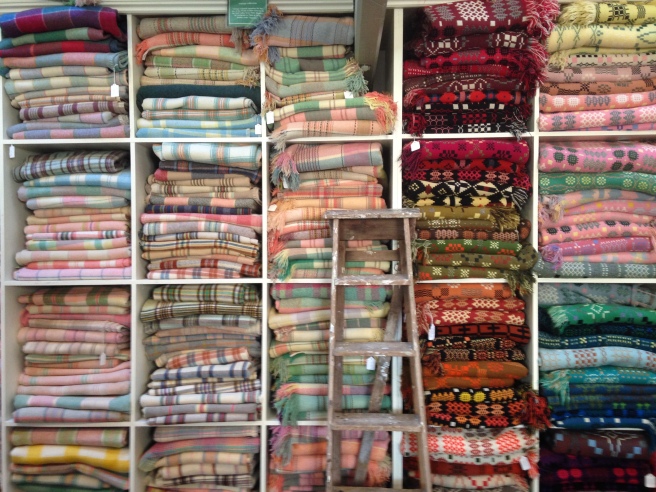 I ended up in the same place despite taking a different route! I had been in contact with the National Wool museum, however after having waited a period of time for their next reply and not hearing from them, I got to thinking of somewhere else I could go, that might be nearer and a bit more accessible. I desperately need this as I am already so frustratingly limited with the little time I get to work on this course. Anyway I am glad for having these decisions to make because I got led to a meeting with a fascinating woman who holds a collection of Welsh blankets. Jane Beck owns and runs a shop housed in a beautiful tin shed. She sells both heritage, antique blankets and brand new ones that she has made for her at the mill. She also has her own private collection and was a wealth of knowledge when I went on my first visit to meet her this week.
I ended up in the same place despite taking a different route! I had been in contact with the National Wool museum, however after having waited a period of time for their next reply and not hearing from them, I got to thinking of somewhere else I could go, that might be nearer and a bit more accessible. I desperately need this as I am already so frustratingly limited with the little time I get to work on this course. Anyway I am glad for having these decisions to make because I got led to a meeting with a fascinating woman who holds a collection of Welsh blankets. Jane Beck owns and runs a shop housed in a beautiful tin shed. She sells both heritage, antique blankets and brand new ones that she has made for her at the mill. She also has her own private collection and was a wealth of knowledge when I went on my first visit to meet her this week.
Of course I thought I would just go in, select 3 blankets, take lots of photos and that would be that. But it’s not going to work like that. For starters, look at my title image! I left armed with pages of written notes and this book (one of the ‘bibles’ for those who want to know anything about this industry) with a return date next week for the next instalment.
Jane kindly gave me her time and knowledge and began by leading me through the different categories of heritage blankets she has for sale in her shop.
 The first two columns are made up of blankets mainly from the 1950s. Some are a little earlier, just post war. You can tell those by the more grey and brown palettes which used up the old military yarns. The rest are pastel pinks and greens, typical of the 1950’s popular colour schemes. One interesting point is that blankets always came in pairs.
The first two columns are made up of blankets mainly from the 1950s. Some are a little earlier, just post war. You can tell those by the more grey and brown palettes which used up the old military yarns. The rest are pastel pinks and greens, typical of the 1950’s popular colour schemes. One interesting point is that blankets always came in pairs.
The third column houses ‘Carthenni’ bedcovers that can be differentiated by having fringes. That is, if made in Carmarthenshire; the features of a Carthenni change from county to county. These were woven on both narrow width looms and power looms.
The fourth column shows the tapestry blankets from the later 1950’s and 60’s. These were woven as a ‘double cloth’ weave using two types of weft and warp. These were encouraged by the Rural Industries Board. This was due to seeing a rise in working class tourism. Women were working, families taking holidays to the seaside, and the Welsh mills capitalised on this. These blankets were sold on market stalls, in little shops (where they were paid for in instalments) and larger department stores. These tapestry style blankets have regained popularity in recent years. One of the most well known patterns is the ‘Caernarfon’ design. Jane gave me lots of information about the history of this pattern, and I am possibly considering selecting one of these as one of my 3 archive pieces as they seem to be so iconic.
In the final column are the older Carthenni, some dating from the turn of the century. You can see the difference again through the colour schemes. Whilst the late 50s and early 60s designs use strong oranges, reds and browns, the earlier ones have yellow, blues and green. I like a lot of these older ones. The older tapestry ones feel thicker, and were handwoven mostly in North Wales.
Jane and I also talked about the tradition of having a mill in nearly every parish. The common practice was to being your own fleece and get it weighed. I learnt a little bit more of the processes from fleece to blanket, the different types of dyeing such as batch dyeing and hank dyeing. About natural and synthetic dyes and interesting snippets such as how the Germans controlled the dye industry and how as a result of the war there was a dye drought. The Americans then developed new synthetic dyes.
Mills in West Wales had kept going through military contracts buoying the Teifi Valley. However the end of the wars saw their demise. There was a surplus of yarn to use up, wool was going out of fashion and synthetics were becoming all the rage.
I feel like I have only just skimmed the surface and look forward to returning and picking the 3 pieces to work with.

This sounds like the start of a very interesting assignment. You’re very fortunate to find such an accessible archive.
LikeLike
Thank you for the comment! I have enjoyed delving in to the woollen blanket world!
LikeLike